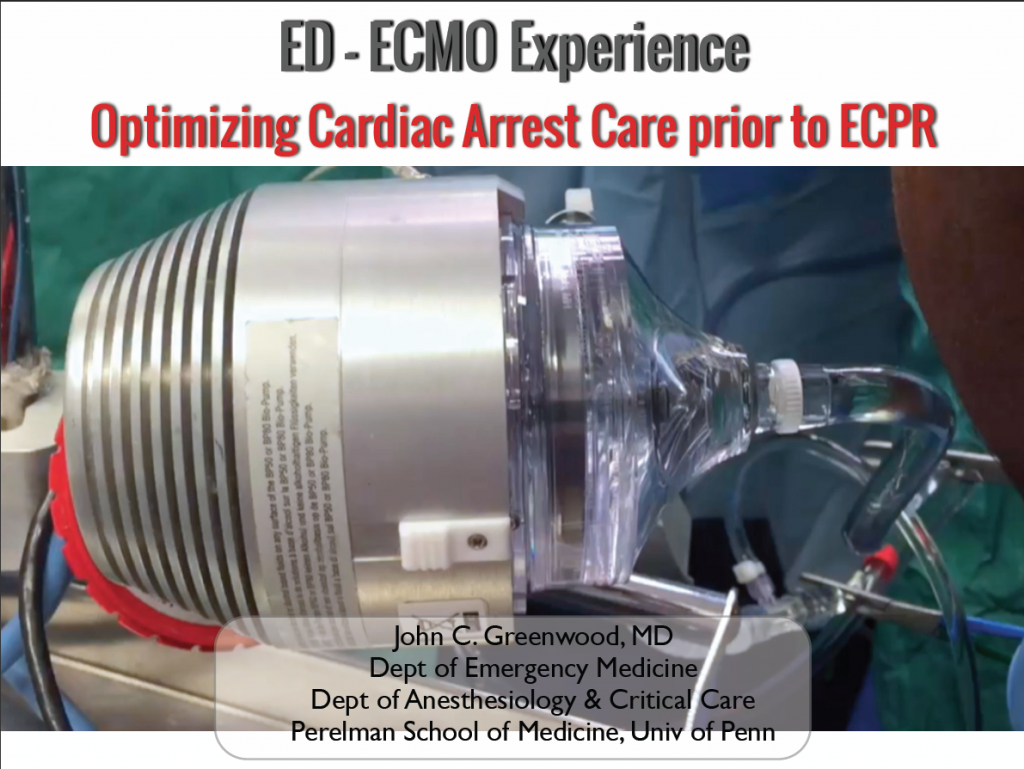[x_section style=”margin: 0px 0px 0px 0px; padding: 25px 0px 0px 0px; border-style: ridge; border-width: 1px 1px 1px 1px; “][x_row inner_container=”true” marginless_columns=”false” bg_color=”” style=”margin: 0px auto 0px auto; padding: 0px 0px 0px 0px; “][x_column bg_color=”” type=”1/1″ style=”padding: 0px 0px 0px 0px; “][x_text]Author: Dr. Rachel Zang
Reviewer & Edits: Dr. John Greenwood[/x_text][/x_column][/x_row][/x_section][x_section style=”margin: 0px 0px 0px 0px; padding: 0px 0px 0 0px; “][x_row inner_container=”true” marginless_columns=”false” bg_color=”” style=”margin: 0px auto 0px auto; padding: 0px 0px 0px 0px; “][x_column bg_color=”” type=”1/1″ style=”padding: 0px 0px 0px 0px; “][x_text]
Clinical Case
63 yo female with PMHx CAD, pulmonary HTN, and right side heart failure presents to the emergency department after witnessed cardiac arrest and return of spontaneous circulation (ROSC). Pt is intubated on a ventilator with post-ROSC GCS of 3T.
Vital signs: Temp: 37.1 °C, BP:132/80, HR:68, RR:20 SpO2:100% on 40% FiO2.
How should we approach the induction phase of targeted temperature management (TTM) for this patient?[/x_text][/x_column][/x_row][/x_section][x_section style=”margin: 0px 0px 0px 0px; padding: 0px 0px 0px 0px; “][x_row inner_container=”true” marginless_columns=”false” bg_color=”” style=”margin: 0px auto 0px auto; padding: 0px 0px 0px 0px; “][x_column bg_color=”” type=”1/1″ style=”padding: 0px 0px 0px 0px; “][x_text]
Who should be cooled after ROSC and when?
[/x_text][/x_column][/x_row][x_row inner_container=”true” marginless_columns=”false” bg_color=”” style=”margin: 0px auto 0px auto; padding: 0px 0px 0px 0px; “][x_column bg_color=”” type=”1/1″ style=”padding: 0px 0px 0px 0px; “][x_accordion][x_accordion_item title=”Answer” open=”false”]PEARL: Patients after any type of cardiac arrest should be started on TTM and early!
Early studies with TTM included only patients with VT/VF arrest; however, indications for TTM have been expanded to include all types of cardiac arrest.
- Indications for TTM vary with institutions, but generally are as follows:
ROSC after any type of cardiac arrest - Patient is comatose (GCS <6)
- Time 65mmHg (with or without pressors)
It is important to try to induce hypothermia within one hour of obtained ROSC, as protection appears to be greater when cooling is initiated early. The new International Liaison Committee on Resuscitation (ILCOR) guidelines recommend against pre-hospital cooling with cold intravenous fluids as it has not been shown to change survival outcomes and has been associated to increased adverse events (i.e. pulmonary edema, re-arrest).[/x_accordion_item][/x_accordion][/x_column][/x_row][/x_section][x_section style=”margin: 0px 0px 0px 0px; padding: 0px 0px 0px 0px; “][x_row inner_container=”true” marginless_columns=”false” bg_color=”” style=”margin: 0px auto 0px auto; padding: 0px 0px 0px 0px; “][x_column bg_color=”” type=”1/1″ style=”padding: 0px 0px 0px 0px; “][x_text]
How are you going to reach your target temperature?
[/x_text][x_accordion][x_accordion_item title=”Answer” open=”false”]PEARL: Using multiple types of cooling techniques may be beneficial and rapid induction decreases the risks of shivering and metabolic disorders.
There are three main types of cooling techniques:
- Conventional cooling techniques
- Surface cooling systems
- Intravascular cooling systems
Conventional cooling techniques such as cold saline & ice bags are effective in inducing hypothermia and are easy to readily implement upon a patient’s arrival to the hospital. The advantages are that they are cheaper and quickly accessible. The disadvantages are unintentional cooling below target temperature and less effect at maintaining target temperature.
[x_blockquote type=”left”]A good rule of thumb is that a 30 ml/kg bolus of 4° C saline or Hartmann’s solution will decrease core temperature by approximately 1.0–1.5° C .[/x_blockquote]
Surface cooling techniques include cooling blankets or pads wrapped around the patient. There are a variety of commercial products currently available with limited data to suggest one product is superior over another. The advantages are the ease of application and the rapid initiation of treatment. Disadvantages are rare risk of skin burn/skin irritation and shivering is more commonly seen with surface systems than with other systems.
Intravascular cooling systems utilize central venous catheters and temperature control is achieved by circulating cool and warm saline in a closed loop through the catheter’s balloon. There are a number of advantages such as precise temperature control, easy to maintain a specific temperature, and less shivering. However, there is no difference in outcome when compared to surface cooling devices and gaining central venous access can be cumbersome with additional risk of line infections and venous thrombosis as complications.
Bottom line: Using both conventional cooling methods (1500-3000ml of cooled saline) in conjunction with surface cooling techniques is the fastest way to cool your patient in the induction phase with careful monitoring for shivering and overcooling.[/x_accordion_item][/x_accordion][/x_column][/x_row][/x_section][x_section style=”margin: 0px 0px 0px 0px; padding: 0px 0px 0px 0px; “][x_row inner_container=”true” marginless_columns=”false” bg_color=”” style=”margin: 0px auto 0px auto; padding: 0px 0px 0px 0px; “][x_column bg_color=”” type=”1/1″ style=”padding: 0px 0px 0px 0px; “][x_text]
How should you approach shivering during the induction phase of TTM?
[/x_text][x_accordion][x_accordion_item title=”Answer” open=”false”]PEARL: The faster you cool your patient, they less likely they are to shiver. The shivering response is markedly diminished at temperatures below 33.5C.
The shivering patient can be managed with sedatives, opiates, magnesium, and muscle paralyzers. In the hypotensive patient or in the emergency department, paralytics can be considered first line management for shivering.
In the hemodynamically stable patient, particularly in the ICU, efforts should be made to minimize the use of paralytics and attempt other medications first. Opiates and sedative medications (such as fentanyl, morphine, & propofol) should be utilized first for shivering. Magnesium, a naturally occurring NMDA receptor antagonist, decreases the shivering threshold and can also be given as “pre-emptive” electrolyte repletion as well. Meperidine is also a useful adjunctive medication to combat shivering and causes relatively mild hypotension. Paralytics should be used sparingly as it can mask seizures, may mask insufficient sedation, and carries an increased risk of critical illness polyneuromyopathy.[/x_accordion_item][/x_accordion][/x_column][/x_row][/x_section][x_section style=”margin: 0px 0px 0px 0px; padding: 0px 0px 0px 0px; “][x_row inner_container=”true” marginless_columns=”false” bg_color=”” style=”margin: 0px auto 0px auto; padding: 0px 0px 0px 0px; “][x_column bg_color=”” type=”1/1″ style=”padding: 0px 0px 0px 0px; “][x_text]
How should you approach oxygenation and ventilation using an ABG in the TTM patient?
[/x_text][/x_column][/x_row][x_row inner_container=”true” marginless_columns=”false” bg_color=”” style=”margin: 0px auto 0px auto; padding: 0px 0px 0px 0px; “][x_column bg_color=”” type=”1/1″ style=”padding: 0px 0px 0px 0px; “][x_accordion][x_accordion_item title=”Answer” open=”false”]PEARL: Blood gas values are temperature dependent. PaO2 and PaCO2 are overestimated and pH underestimated in warmed blood gas analysis; this must be considered when managing the ventilator with TTM.
It is imperative to temperature correct PaO2 to ensure you are not causing hypoxic or hyperoxic insults to your patient. The FiO2 should only be adjusted to temperature correct PaO2.
[x_blockquote type=”left”]In general, temperature correction of PO2 and PCO2 can be calculated as follows:
- PO2 is 5 mmHg lower for each degree below 37C°
- PCO2 is 2mmHg lower for each degree below 37C°[/x_blockquote]
There are two concepts used to approach temperature adjusted blood gas management.
- Alpha-stat is the concept of PaCO2 obtained by measurements at 37° C is kept constant regardless of the actual body temperature.
- pH-stat is the concept of correcting the PaCO2 for actual body temperature and is held constant at the same level as during normothermia.
Which method is superior has not been determined. pH-stat supporters cite induction of a degree of hypercapnia leading to cerebral vasodilation is superior to alpha-stat that causes hyperventilation, hypocapnia and hypocapnia-induced cerebral vasoconstriction. However, hypercapnia can impair cerebral autoregulation and some animal studies suggest respiratory alkalosis is physiologically appropriate during hypothermia to preserve normal physiologic conditions.[/x_accordion_item][/x_accordion][/x_column][/x_row][/x_section][x_section bg_color=”#f4f4f4″ style=”margin: 0px 0px 0px 0px; padding: 0px0 0px 0 0px; border-style: solid; border-width: 1px 1px 1px 1px; border-color: #a0a0a0; “][x_row inner_container=”true” marginless_columns=”false” bg_color=”” style=”margin: 0px auto 0px auto; padding: 0px 0px 0px 0px; “][x_column bg_color=”” type=”1/1″ style=”padding: 0px 0px 0px 0px; “][x_text]References & Suggested Reading
- Vaity C, Al-subaie N, Cecconi M. Cooling techniques for targeted temperature management post-cardiac arrest. Crit Care. 2015;19:103. [PubMed Link]
- Polderman KH, Herold I. Therapeutic hypothermia and controlled normothermia in the intensive care unit: practical considerations, side effects, and cooling methods. Crit Care Med. 2009;37(3):1101-20. [PubMed Link]
- Perman SM, Goyal M, Neumar RW, Topjian AA, Gaieski DF. Clinical applications of targeted temperature management. Chest. 2014;145(2):386-93. [PubMed Link]
- Donnino MW, Andersen LW, Berg KM, et al. Temperature Management After Cardiac Arrest An Advisory Statement by the Advanced Life Support Task Force of the International Liaison Committee on Resuscitation and the American Heart Association Emergency Cardiovascular Care Committee and the Council on Cardiopulmonary, Critical Care, Perioperative and Resuscitation. Resuscitation. 2015; [PubMed Link]
[/x_text][/x_column][/x_row][/x_section]

